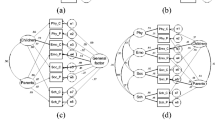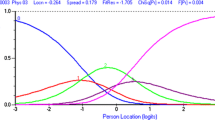Abstract
Objective: The aim of this study was to assess the psychometric properties of the Dutch translation of the Pediatric Quality of Life InventoryTM (PedsQLTM 4.0) generic core scales and assess its usefulness in measuring quality of life (QoL) in a child psychiatric population. Methods: Reliability and validity of the PedsQL were assessed in 310 referred children (ages 6–18 years) and a comparison group consisting of 74 non-referred children (ages 7–18 years), and the parents in both groups. Results: Confirmatory factor analysis resulted in a four-factor solution. Internal consistency reliability for the PedsQL Total Scale Score (α = 0.84 child self-report, α = 0.87 parent proxy-report), Psychosocial Health Score (α = 0.70 child self-report, α = 0.81 parent proxy-report), and most subscale scores were acceptable for group comparisons. Correlations between scores of fathers and mothers were large. Criterion-related validity was demonstrated by significantly lower PedsQL scores for referred vs. non-referred children. Significant correlations between PedsQL scales and measures of psychopathology showed convergent validity. Small correlations between PedsQL scales and intelligence of the child evidenced discriminant validity. Conclusion: The PedsQL seems a valid instrument in measuring QoL in children referred for psychiatric problems.
Similar content being viewed by others
References
Bradlyn AS, Ritchey AK, Harris CV, et al. Quality of life research in pediatric oncology. Research methods and barriers. Cancer 1996; 78(6): 1333-1339.
Juniper EF, Guyatt GH, Feeny DH, Ferrie PJ, Griffith LE, Townsend M. Measuring quality of life in children with asthma. Qual Life Res 1996; 5(1): 35-46.
Graham P, Stevenson J, Flynn D. A new measure of health-related quality of life for children: Preliminary findings. Psychol Health 1997; 12(5): 655-665.
Landgraf JM, Abetz L, Ware JE. The CHQ User's Manual. Boston: The Health Institute, New England Center, 1996.
Clark DB, Kirisci L. Posttraumatic stress disorder, depression, alcohol use disorders and quality of life in adolescents. Anxiety 1996; 2(5): 226-233.
Varni JW, Seid M, Kurtin PS. PedsQL 4.0™: Reliability and validity of the Pediatric Quality of Life Inventory™ version 4.0 Generic Core Scales in healthy and patient populations. Med Care 2001; 39(8): 800-812.
World Health Organization. Constitution of the World Health Organization basic documents. Geneva: World Health Organization, 1948.
Varni JW, Seid M, Rode CA. The PedsQL™: Measurement model for the Pediatric Quality of Life Inventory. Med Care 1999; 37(2): 126-139.
Achenbach TM. Manual for the Child Behavior Checklist/4-18 and 1991 Profile. Burlington: University of Vermont Department of Psychiatry, 1991.
Achenbach TM. Manual for the Youth Self-Report and 1991 Profile. Burlington: University of Vermont Department of Psychiatry, 1991.
Wechsler D. Manual for the Wechsler Intelligence Scale for Children-Revised. New York: Psychological Corporation, 1974.
Van Haasen PP, De Bruyn EEJ, Pijl YL, et al. Wisc-R: Wechsler Intelligence Scale for Children-Revised. Dutch version. Lisse: Swets & Zeitlinger, 1986.
Cronbach LJ. Coefficient alpha and the internal structure of tests. Psychometrika 1951; 16: 297-334.
Muthén LK, Muthén BO. Mplus User's Guide. In: Los Angeles: Muthén & Muthén, 1998.
Steiger JH. A note on multiple sample extensions of the RMSEA fit index. Struct Equat Mod 1998; 5(4): 411-419.
Bentler PM. Comparative fix indexes in structural models. Psychol Bull 1990; 107(2): 238-246.
Cohen J. Statistical Power Analysis for the Behavioral Sciences 2nd edn Hillsdale, NJ: Erlbaum, 1988.
Steiger JH. Tests for comparing elements of a correlation matrix. Psychol Bull 1980; 87(2): 245-251.
Hays RD, Anderson R, Revicki D. Psychometric considerations in evaluating health-related quality of life measures. Qual Life Res 1993; 2(6): 441-449.
Achenbach TM, McConaughy SH, Howell CT. Child/adolescent behavioral and emotional problems: Implications of cross-informant correlations for situational specificity. Psychol Bull 1987; 101(2): 213-232.
Varni JW, Burwinkle TM, Katz ER, Meeske K, Dickinson P. The PedsQL in pediatric cancer: Reliability and validity of the Pediatric Quality of Life Inventory Generic Core Scales, Multidimensional Fatigue Scale, and Cancer Module. Cancer 2002; 94(7): 2090-2106.
Varni JW, Seid M, Smith Knight T, Burwinkle TM, Brown J, Szer IS. The PedsQL™ in pediatric rheumatology: Reliability, validity and responsiveness of the Pediatric Quality of Life Inventory™ generic core scales and rheumatology module. Arthritis Rheum 2002; 46: 714-725.
Author information
Authors and Affiliations
Rights and permissions
About this article
Cite this article
Bastiaansen, D., Koot, H., Bongers, I. et al. Measuring quality of life in children referred for psychiatric problems: Psychometric properties of the PedsQLTM 4.0 generic core scales. Qual Life Res 13, 489–495 (2004). https://doi.org/10.1023/B:QURE.0000018483.01526.ab
Issue Date:
DOI: https://doi.org/10.1023/B:QURE.0000018483.01526.ab




